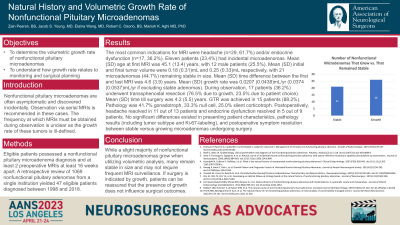Natural History and Volumetric Growth Rate of Nonfunctional Pituitary Microadenomas
Friday, April 21, 2023


Zain Peeran, BS
Medical Student
University of California, San Francisco, School of Medicine
San Francisco, California, United States
ePoster Presenter(s)
Introduction: Nonfunctional pituitary microadenomas are often asymptomatic and discovered incidentally. Observation via serial MRIs is recommended in these cases. The frequency at which MRIs must be obtained during observation is unclear as the growth rate of these tumors is ill-defined.
Methods: Eligible patients possessed a nonfunctional pituitary microadenoma diagnosis and at least 2 preoperative MRIs at least 16 weeks apart. A retrospective review of 1069 nonfunctional pituitary adenomas from a single institution yielded 47 eligible patients diagnosed between 1998 and 2018.
Results: The most common indications for MRI were headache (n=29, 61.7%) and/or endocrine dysfunction (n=17, 36.2%). Eleven patients (23.4%) had incidental microadenomas. Mean (SD) age at first MRI was 45.1 (13.4) years, with 12 male patients (25.5%). Mean (SD) initial and final tumor volume were 0.18 (0.31)mL and 0.25 (0.33)mL respectively, with 21 microadenomas (44.7%) remaining stable in size. Mean (SD) time difference between the first and last MRI was 4.6 (3.9) years. Mean (SD) growth rate was 0.0207 (0.0438)mL/yr (0.0374 (0.0537)mL/yr if excluding stable adenomas). During observation, 17 patients (36.2%) underwent transsphenoidal resection (76.5% due to growth, 23.5% due to patient choice). Mean (SD) time till surgery was 4.2 (5.5) years. GTR was achieved in 15 patients (88.2%). Pathology was 41.7% gonadotroph, 33.3% null cell, 25.0% silent corticotroph. Postoperatively, headache resolved in 11 out of 13 patients and endocrine dysfunction resolved in 5 out of 9 patients. No significant differences existed in presenting patient characteristics, pathology results (including tumor subtype and Ki-67-labeling), and postoperative symptom resolution between stable versus growing microadenomas undergoing surgery.
Conclusion : While a slight majority of nonfunctional pituitary microadenomas grow when utilizing volumetric analysis, many remain stable in size and may not require frequent MRI surveillance. If surgery is indicated by growth, patients can be reassured that the presence of growth does not influence surgical outcomes.
Methods: Eligible patients possessed a nonfunctional pituitary microadenoma diagnosis and at least 2 preoperative MRIs at least 16 weeks apart. A retrospective review of 1069 nonfunctional pituitary adenomas from a single institution yielded 47 eligible patients diagnosed between 1998 and 2018.
Results: The most common indications for MRI were headache (n=29, 61.7%) and/or endocrine dysfunction (n=17, 36.2%). Eleven patients (23.4%) had incidental microadenomas. Mean (SD) age at first MRI was 45.1 (13.4) years, with 12 male patients (25.5%). Mean (SD) initial and final tumor volume were 0.18 (0.31)mL and 0.25 (0.33)mL respectively, with 21 microadenomas (44.7%) remaining stable in size. Mean (SD) time difference between the first and last MRI was 4.6 (3.9) years. Mean (SD) growth rate was 0.0207 (0.0438)mL/yr (0.0374 (0.0537)mL/yr if excluding stable adenomas). During observation, 17 patients (36.2%) underwent transsphenoidal resection (76.5% due to growth, 23.5% due to patient choice). Mean (SD) time till surgery was 4.2 (5.5) years. GTR was achieved in 15 patients (88.2%). Pathology was 41.7% gonadotroph, 33.3% null cell, 25.0% silent corticotroph. Postoperatively, headache resolved in 11 out of 13 patients and endocrine dysfunction resolved in 5 out of 9 patients. No significant differences existed in presenting patient characteristics, pathology results (including tumor subtype and Ki-67-labeling), and postoperative symptom resolution between stable versus growing microadenomas undergoing surgery.
Conclusion : While a slight majority of nonfunctional pituitary microadenomas grow when utilizing volumetric analysis, many remain stable in size and may not require frequent MRI surveillance. If surgery is indicated by growth, patients can be reassured that the presence of growth does not influence surgical outcomes.
